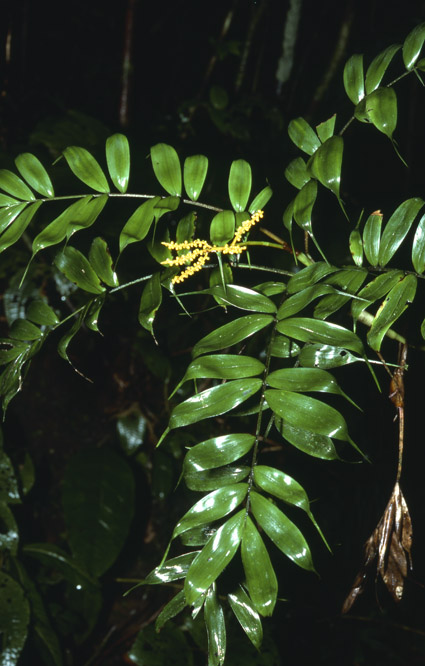- Acanthophoenix
- Acrocomia
- Actinokentia
- Actinorhytis
- Adonidia
- Aiphanes
- Allagoptera
- Ammandra
- Aphandra
- Archontophoenix
- Areca
- Arenga
- Asterogyne
- Astrocaryum
- Attalea
- Bactris
- Balaka
- Barcella
- Basselinia
- Beccariophoenix
- Bismarckia
- Borassodendron
- Borassus
- Brassiophoenix
- Burretiokentia
- Butia
- Calamus
- Calyptrocalyx
- Calyptrogyne
- Calyptronoma
- Carpentaria
- Carpoxylon
- Caryota
- Ceratolobus
- Ceroxylon
- Chamaedorea
- Chamaerops
- Chambeyronia
- Chelyocarpus
- Chuniophoenix
- Clinosperma
- Coccothrinax
- Cocos
- Corypha
- Cryosophila
- Cyphokentia
- Cyphophoenix
- Cyphosperma
- Daemonorops
- Deckenia
- Desmoncus
- Dictyocaryum
- Drymophloeus
- Elaeis
- Eleiodoxa
- Eremospatha
- Eugeissona
- Euterpe
- Gaussia
- Geonoma
- Guihaia
- Hedyscepe
- Hemithrinax
- Howea
- Hyophorbe
- Hyospathe
- Hyphaene
- Iriartea
- Iriartella
- Itaya
- Jailoloa
- Johannesteijsmannia
- Juania
- Jubaea
- Jubaeopsis
- Kentiopsis
- Kerriodoxa
- Korthalsia
- Laccospadix
- Laccosperma
- Lanonia
- Latania
- Lemurophoenix
- Leopoldinia
- Lepidocaryum
- Lepidorrhachis
- Leucothrinax
- Licuala
- Linospadix
- Livistona
- Lodoicea
- Lytocaryum
- Manicaria
- Manjekia
- Marojejya
- Masoala
- Mauritia
- Mauritiella
- Maxburretia
- Medemia
- Metroxylon
- Myrialepis
- Nannorrhops
- Nenga
- Neonicholsonia
- Neoveitchia
- Nephrosperma
- Normanbya
- Nypa
- Oenocarpus
- Oncocalamus
- Oncosperma
- Orania
- Oraniopsis
- Parajubaea
- Pelagodoxa
- Phoenicophorium
- Phoenix
- Pholidocarpus
- Pholidostachys
- Physokentia
- Phytelephas
- Pigafetta
- Pinanga
- Plectocomia
- Plectocomiopsis
- Podococcus
- Pogonotium
- Ponapea
- Prestoea
- Pseudophoenix
- Ptychococcus
- Ptychosperma
- Raphia
- Ravenea
- Reinhardtia
- Retispatha
- Rhapidophyllum
- Rhapis
- Rhopalostylis
- Roscheria
- Roystonea
- Sabal
- Sabinaria
- Salacca
- Saribus
- Satakentia
- Satranala
- Schippia
- Sclerosperma
- Socratea
- Solfia
- Sommieria
- Syagrus
- Synechanthus
- Tahina
- Tectiphiala
- Thrinax
- Trachycarpus
- Trithrinax
- Veitchia
- Verschaffeltia
- Voanioala
- Wallaceodoxa
- Wallichia
- Welfia
- Wendlandiella
- Wettinia
- Wodyetia
- Zombia
- x Jubautia splendens
- ?? Acoelorrhaphe
- ?? Bentinckia
- ?? Brahea
- ?? Clinostigma
- ?? Colpothrinax
- ?? Copernicia
- ?? Cyrtostachys
- ?? Dictyosperma
- ?? Dransfieldia
- ?? Heterospathe
- ?? Hydriastele
- ?? Iguanura
- ?? Incertae sedis & excluded names
- ?? Loxococcus
- ?? Micronoma
- ?? Paripon
- ?? Pritchardia
- ?? Rhopaloblaste
- ?? Serenoa
- ?? Washingtonia

Introduction
- A very distinctive species with its long-acuminate, even caudate leaflet tips (hence the name), which are pendulous at almost right angles to the main part of the leaf. The custard yellow flowers are particularly attractive. (Dransfield, J. & Beentje, H. 1995: The Palms of Madagascar)A
Discussion
- Probably related to D. linearis but very distinct in its leaflets with their long drip-tips. (Dransfield, J. & Beentje, H. 1995: The Palms of Madagascar)A
Diagnosis
- a ceteris speciebus 6-staminatis caulibus caespitosis foliolis fasciculatis ovatis abrupte caudati distincta. (Dransfield, J. & Beentje, H. 1995: The Palms of Madagascar)A
Biology And Ecology
- Lowland rain forest; steep slope or valley bottom; 50-300 m. (Dransfield, J. & Beentje, H. 1995: The Palms of Madagascar)A
Conservation
- Critical. Only known from a single site, in an unprotected area. Numbers are thought to be low. (Dransfield, J. & Beentje, H. 1995: The Palms of Madagascar)A
Common Name
- Not recorded. (Dransfield, J. & Beentje, H. 1995: The Palms of Madagascar)A
Uses
- Not recorded. (Dransfield, J. & Beentje, H. 1995: The Palms of Madagascar)A
Description
- Clustering palm. STEMS 1-3 m, 0.5-1.5 cm diam.; internodes 1-6 cm, green when young, later blackish, distally with dark scales; crownshaft indistinct. LEAVES 6-11 in the crown; sheath c. 10 cm long, pale green with dense dark scales or later with scattered scales; petiole 6-20 cm long, 2-3 mm diam., rusty-scaly, becoming more glabrous; rachis 25-46 cm long, in mid-leaf 2-2.5 mm wide, rusty-scaly; leaflets 11-15 on each side of the rachis, in groups of 2-4, group interval 4-7 cm, proximal 8-10 x 0.5-1.5 cm, median 8-14 x 1.5-2.2 cm, distal 6-8 x 1-2.2 cm, narrowly obovate, with abrupt and pendulous drip-tips 2-4 cm long, main vein 1, with scattered scales on the minor veins and when young with bands of scales on the adaxial midrib, and on the margins (especially on the distal margin), distal pair joined for < 1 cm, dentate over c. 10 mm. INFLORESCENCE branched to 1 order, custard orange-yellow; peduncle c. 31 cm long, c. 1.5 mm diam., scaly; prophyll 19-29 cm long, 4-7 mm wide, opening in the distal 1 cm only, with scattered scales; peduncular bract inserted at c. 16 cm from the base of the peduncle, c. 11 cm long; non-tubular peduncular bract 2-4 mm long; rachis c. 7 cm long, with c. 11 branches; rachillae orange, 4-5.5 cm long, c. 1 mm diam., minutely puberulous and scaly. STAMINATE FLOWERS with sepals 0.7-0.8 x 0.7-0.8 mm; petals orange, 1.5-1.7 x 1.4-1.5 mm; stamens 6, biseriate (offset 0.2 mm), filaments 0.6-0.8 mm, thin; anthers 1-1.2 x 0.7 mm; pistillode c. 0.8 x 0.3-0.4 mm. PISTILLATE FLOWERS with sepals 0.7-0.8 x 0.6-1 mm; petals orange, 2.2-2.3 x 1.5-2.4 mm; staminodes 6, c. 0.4 mm; pistil c. 2.2 x 1.5 mm. FRUIT orange, 8-11 x 3.5-5 mm. SEED c. 7 x 3.5 mm, with homogeneous endosperm. (Dransfield, J. & Beentje, H. 1995: The Palms of Madagascar)A
Materials Examined
- Maroantsetra: Antalavia, Feb. 1988 (fl., y.fr.), Dransfield et al. JD6478 (Holotype K; isotype TAN); idem, April 1988 (fr.), Gentry & Schatz 62179 (K); idem, Nov. 1989 (bud), Dransfield et al. JD6741 (K, TAN). (Dransfield, J. & Beentje, H. 1995: The Palms of Madagascar)A
- Log in to post comments

